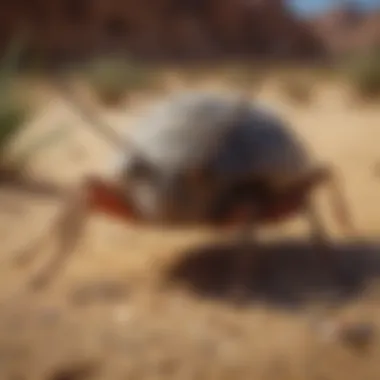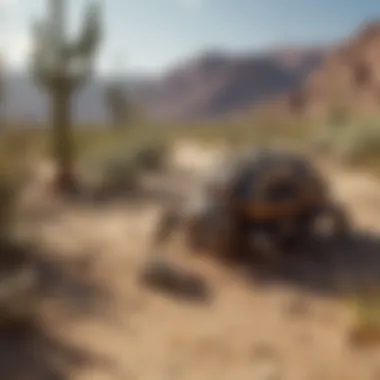Desert Valley Pest Control: Strategies and Insights


Preventive Pest Control Strategies
When it comes to pest control in desert valleys, a proactive approach can make all the difference. Creating a sanctuary that keeps pests at bay begins with preventive strategies designed to tackle potential problems before they escalate.
House Exterior Protection
To defend your home from the small intruders that can wreak havoc, it’s essential to fortify the exterior. Here are a few tips for sealing cracks:
- Identify vulnerabilities: Examine the foundation and outer walls carefully. Look for holes and gaps that could serve as doorways for pests.
- Use caulk generously: An effective way to seal cracks is by utilizing quality caulking products. Focus on entry points such as around windows, door frames, and utility pipes.
- Install door sweeps: These can help block gaps beneath doors that might allow pests access.
Maintaining a clean and clear exterior is also crucial. Clearing away debris, such as piles of leaves and yard clutter, can minimize hideouts for pests. Consider implementing these key practices to keep your outdoor space pest-free:
- Keep gutters clean to prevent standing water.
- Regularly trim bushes and trees to reduce hanging branches that might act as bridges for pests.
- Mow the lawn to prevent tall grass—the perfect hangout spot for critters.
Yard Maintenance
A well-kept yard not only enhances your home's appeal but also prevents pest infestations. Here are essential yard care routines:
- Water wisely: Overwatering plants creates damp conditions that attract pests. Early mornings are ideal for watering to let plants dry out later in the day.
- Mulch smartly: While mulch helps retain moisture, too thick a layer can become a breeding ground for insects. Opt for about two inches, keeping it away from your home's foundation.
- Check plant health: Regularly inspect plants for signs of pests or disease that could attract unwanted guests.
Indoor Cleanliness
An often-overlooked aspect of pest control is maintaining indoor cleanliness. Here are expert cleaning tips:
- Tidy up regularly: Routine cleaning eliminates food crumbs and spills that can attract pests. This might be as simple as wiping down counters and sweeping floors.
- Store food securely: Keeping food sealed in airtight containers can help deter insects from making your pantry their new home.
- Vacuum frequently: Don't just clean the floors—don’t forget hidden corners and behind appliances!
By maintaining a pest-resistant indoor environment, you can significantly reduce the inviting conditions pests thrive in.
Garbage Disposal
Proper waste management is pivotal in pest prevention. Here’s how to manage garbage effectively:
- Utilize bins with tight-fitting lids to keep pests like rodents and insects at bay.
- Bury or compost waste like food scraps carefully, as leaving them exposed can lure unwanted guests.
- Regularly take out the trash and avoid allowing it to pile up in your home.
Other Pest Prevention Strategies
Beyond these methods, consider some innovative ways to safeguard your home:
- Natural barriers: Planting pest-repelling plants such as marigolds or lavender can deter many critters.
- Ultrasonic repellents: Devices that emit high-frequency sounds can keep rodents and some insects away.
Being proactive not only saves time and hassle; it also maintains a habitat that is less inviting to pests, enhancing both your living conditions and peace of mind.
Identifying Pest Risk Areas
Identifying areas within and around your home that are susceptible to pest problems is another crucial step toward effective pest control.
Moisture Prone Areas Inspection
Moisture is a major attractant for pests, thus, identify damp conditions:
- Look for leaking pipes and water accumulation in basements or attics.
- Tips for preventing infestations include repairing leaks swiftly and ensuring good ventilation in humid areas.
Crack and Crevice Inspection Guide
Access points like cracks and crevices can create vulnerabilities. Take time to inspect these areas:
- Seal cracks found in walls or foundations using a quality filler or caulk, enhancing your home’s defenses.
Greenery Inspection for Pest Risks
Often overlooked, greenery can impact pest populations significantly:
- Understand how shrubs and trees may create hiding spots or serve as pathways for pests.
- Guidelines for maintaining pest-free yards include keeping vegetation trimmed and eliminating dense plant growth near homes.
Additional Pest Risk Areas
Don't forget about miscellaneous areas that might harbor pests:
- Sheds and garages: Regularly check these spaces for clutter and moisture, ensuring they don't become a breeding ground.
- Outdoor furniture: Store or regularly clean to prevent attracting pests.
Effective Pest Control Methods
Active pest control goes beyond just prevention. It includes employing effective methods tailored to the unique challenges of pest management in desert valleys.
Natural Repellents for Pest Control
Safe and effective natural solutions exist to fend off pests:
- Consider using essential oils, such as eucalyptus or peppermint, which are known for repelling various insects.
Chemical Sprays for Pest Control


When opting for professional pest control sprays, it's crucial to follow guidelines:
- Safe usage means strictly adhering to recommended quantities and applying during times when children and pets are less likely to be present.
Pest Traps: Effective Pest Control Solutions
Traps can be a straightforward yet effective way to manage pests:
- Set up and use rodent or insect traps, ensuring they are placed strategically around the home for maximum effect.
Biological Control Methods for Pest Prevention
Utilizing natural predators for pest management can be an environmentally-friendly option:
- Inviting ladybugs into your garden can help control aphid populations naturally.
Other Pest Control Methods
Explore innovative pest control methods that step outside traditional tactics:
- If applicable, integrating heat treatment or steam cleaning can eliminate pests while minimizing chemical use.
Pest Species Identification
Recognizing the types of pests in your area helps create targeted control strategies.
Common Insects in Home Pest Control
Getting to know common insects:
- Types of insects like ants, cockroaches, and spiders can be prevalent.
- Learn management strategies for each kind, as approaches may differ.
Identifying Rodents for Pest Prevention
Rodent identification is vital for prevention:
- Mice and rats can infiltrate homes easily—understanding their habits aids in keeping them out.
Bird Species Impacting Home Environments
Some birds can become nuisances:
- Address issues like bird droppings or nesting around your home.
Dealing with Wildlife on Your Property
If larger critters are causing trouble, understanding how to handle encounters can be key:
- Knowledge of local wildlife behavior and control measures is essential for a peaceful coexistence.
Miscellaneous Pest Species Identification
Lesser-known pests also pose risks:
- Stay informed about any new bugs making an appearance in your area.
DIY Pest Control Techniques
Harnessing DIY pest control can be satisfying and effective.
Homemade Pest Control Solutions
Eco-friendly remedies often involve common household items:
- Mixing soap and water can create a simple insecticide for aphids.
Using Essential Oils for Pest Control
Though not a miracle solution, essential oils can provide some pest-repelling benefits:
- Creating a bug-free environment with oils like citronella or tea tree oil can be as easy as mixing with water in a spray bottle.
Effective Pest Traps and Barriers
Setting up traps and barriers can be done with little effort and expense:
- Simple DIY traps using items like plastic bottles can be quite effective for certain pests like fruit flies.
Top Reputable Pest Control Brands
When it comes to buying products, choosing the right brands ensures reliability. Brands like Raid and Ortho provide a range of products suitable for home management.


Miscellaneous DIY Pest Control Techniques
Exploring other unique solutions can lead to better pest management:
- For instance, chalk can deter ants, as they’re believed to avoid it. Encompass all these methods for a comprehensive approach to pest control.
Understanding the Desert Ecosystem
When tackling pest control in desert valleys, comprehending the unique dynamics of the desert ecosystem is imperative. This understanding lays the groundwork for effective and sustainable pest management strategies. The arid environment, extreme temperatures, and limited water availability create specific challenges that significantly impact both the pests and their natural predators.
Certain characteristics inherent to desert climates drive the habits of pests. For instance, during the blistering heat of day, many insects become dormant or active only at dusk and dawn. Understanding these behaviors can inform the timing of pest control measures. Knowing when pests are active helps in selecting the most effective treatments and mitigating their impact on the environment.
Climate Characteristics
The climate of desert valleys is a central aspect of the ecosystem. Characterized by high evaporation rates and limited rainfall, these regions showcase temperature extremes that can range from scorching days to frosty nights. Such fluctuations affect the life cycles of insects and other pests.
- Seasonal changes: Each season brings unique pest challenges. For example, spring might see an influx of breeding insects whereas autumn could lead to rodents seeking shelter as temperatures drop.
- Drought impact: Extended periods of drought can lead to pests adapting and becoming more resilient, complicating management efforts. When water becomes scarce, pests can invade human habitats in search of moisture.
This deep understanding of climate characteristics helps homeowners prepare and respond effectively.
Biodiversity in Desert Valleys
Biodiversity may seem limited in desert environments, yet it plays a crucial role in the dynamics of pest control. Many insects, reptiles, and mammals inhabit these valleys, creating a delicate balance.
- Predators and prey: Natural predators of common pests, such as lizards, bats, and various insects, maintain the population balance. Recognizing this interaction can inform residents on how to leverage beneficial species instead of solely relying on chemical solutions.
- Indicator species: Some species serve as indicators of ecological health. For instance, certain beetles indicate soil health and can impact agricultural crops as well. Monitoring these species can help foresee pest outbreaks.
Every homeowner should appreciate this biodiversity since it may provide natural pest control benefits right in their backdrop, aligning with the goal of sustainability.
Soil Composition and Its Role
Soil in desert valleys is often sandy or rocky, poorly retaining moisture but rich in minerals. This composition not only affects plant life but also pest populations. The interplay between soil composition and pest control includes several facets, such as:
- Nutrient availability: Healthy soil fosters strong plants, which in turn can repel pests or attract beneficial insects.
- Moisture retention: Knowing the soil's ability to retain moisture can guide homeowners in landscape choices that minimize pest attraction.
Maintaining soil health is important; regular testing and organic amendments can enhance this, leading to fewer pest problems over time. Homeowners who understand their soil can make informed decisions about landscaping and pest management, resulting in healthier surroundings without excessive reliance on chemicals.
Understanding the desert ecosystem not only informs targeted pest management strategies but also emphasizes the interconnectivity of all its elements, from climate to biodiveristy and soil. This holistic view can significantly improve pest control efforts in desert valleys.
Common Pests in Desert Valleys
In the realm of desert maintenance and pest control, understanding the common pests in desert valleys plays an indispensable role. These pests not only disrupt the delicate balance of the ecosystem but also pose serious threats to crops and the general well-being of households. Knowing what to look for and how these critters operate can significantly reduce infestations and safeguard one’s living space.
By zeroing in on prevalent pests, homeowners can formulate effective management strategies that are both proactive and responsive. This section will delve into the specific types of insects, the challenges posed by rodents, and the role of reptiles and arachnids in the desert pest landscape.
Types of Insects
Insects are the most numerous pests encountered in desert valleys. They’ve adapted to thrive in arid environments, making some varieties particularly resilient. One prominent group includes termites, which can silently undermine structures by consuming wood. Their activity might be hard to detect initially but signs, such as discarded wings and mud tubes, can be clear giveaways.
Another common nuisance is the scorpion, known for its menacing appearance but actually more of a fear factor than a widespread threat. While their sting can be painful, they typically only bite in self-defense, and their presence indicates a potential abundance of other pests such as cockroaches and crickets.
Ants also have a strong foothold in these regions. Species like the leafcutter ant and fire ant can invade homes in search of food, making it essential for residents to keep their surroundings clean and food tightly sealed. Here are a few major insect culprits to look out for:
- Termites: Structural health hazards.
- Scorpions: Painful but not deadly in most cases.
- Ants: Plaguing food supply chains.
- Cockroaches: Loving dark, damp environments, they spread diseases and create unclean living conditions.
Rodent Challenges
Rodents such as pack rats and kangaroo rats can present considerable challenges in desert homes. Not only do they pose a threat to food supplies and stored materials, but they can also cause significant damage to wiring and insulation. Their penchant for nesting in attics, basements, and even within walls means homeowners need to be vigilant in monitoring for signs of intrusion.
A few strategies to combat rodent issues include:
- Sealing entry points: Inspect home exteriors and cover any holes with sturdy materials.
- Removing food sources: Properly store food and dispose of trash regularly.
- Employing traps: Both snap and live traps can be effective, although ethical considerations may influence your choice.
Reptiles and Arachnids
The desert reptiles like lizards, while they may seem less menacing, can still impact the ecosystem in unique ways. Many lizards prey on insects, balancing insect populations. However, the presence of certain species can be an indication of insect infestations.
Arachnids, particularly spiders, are another key group in the desert pest landscape. Though often feared, spiders generally help keep other insect populations in check. Species like the black widow and desert recluse are worth noting for their potential effects on health if unwelcomely encountered. Everyone should be aware of their existence and where they prefer to dwell within homes and yards, to minimize risks.
Effective Pest Management Strategies
In desert valleys, effective pest management strategies are not just beneficial; they are essential. The unique climate and diverse ecosystem create distinct challenges for homeowners and property managers. Understanding how to manage these pests effectively ensures the comfort and safety of our living spaces while maintaining harmony with the environment.
This approach goes beyond merely reacting to infestations. It emphasizes a proactive stance, integrating methods that are both efficient and sustainable. Here, we'll delve into key strategies that provide insight into managing pests in these arid landscapes.
Integrated Pest Management Principles
Integrated Pest Management (IPM) is a holistic approach that combines multiple strategies to control pest populations effectively. The core of IPM lies in understanding the pest life cycle, environmental factors, and how these pests interact with their habitat.
- Monitoring and Identification: The first step in IPM involves regularly inspecting your property for signs of pests. This approach ensures that you identify potential issues before they escalate. For instance, if you notice unusual plant damage or disturbances in the soil, it might be time to look closer. Targeting the specific pest species helps tailor your control methods effectively.
- Cultural Practices: These practices encompass everything from selecting pest-resistant plants to altering landscaping techniques that discourage pest habitation. For example, using native plants that are better adapted to the local environment can reduce the need for chemical interventions.
- Physical Controls: Using barriers like screens or traps can help keep pests at bay without chemical exposure. Think of row covers to protect your garden veggies from hungry insects.
"A proactive strategy is always better than a reactive approach, especially when it comes to pest control in delicate ecosystems like desert valleys."


Biological Control Options
Biological control involves using natural predators to manage pest populations. This method is integral to a sustainable pest management strategy and leverages the natural ecosystem to keep pests in check.
- Beneficial Insects: Ladybugs and lacewings are excellent allies. They feed on aphids and other pests that may be troubling your garden. Introducing or encouraging these insects can create a balanced ecosystem right in your yard.
- Microbial Agents: Certain bacteria and fungi can target specific pests without harming beneficial organisms. For example, Bacillus thuringiensis (Bt) is a bacterium that can help manage caterpillar pests in vegetable gardens.
Adopting biological control options encourages resilience against pest invasions over the long haul while minimizing chemical reliance.
Chemical Control Methods
While IPM emphasizes preventive measures and biological control, there are instances requiring chemical interventions. Understanding how to use these responsibly is crucial.
- Selective Pesticides: Rather than broad-spectrum chemical sprays, opt for products that target specific pests. This minimizes the impact on beneficial insects and the environment.
- Application Timing: Timing is everything. Applying chemicals when pests are most vulnerable, and avoiding their peak activity times can increase efficiency and reduce the chances of harming non-target species.
It’s vital to read labels and follow instructions strictly, ensuring safety for both the family and the environment.
Implementing these pest management strategies not only addresses pest populations effectively but also carves out a path toward more sustainable living within the desert ecosystem. By fostering an informed, integrated approach, homeowners can enjoy their living spaces free from pests, all while doing their bit for the community and environment.
Preventative Measures in Pest Control
Effective pest control in desert valleys isn’t just about reaction and remediation; it requires a proactive approach. Understanding and implementing preventative measures is key to reducing the risk of pest infestations. One small change can have a big impact, saving both time and resources in the long run.
Identifying Risk Factors
One of the first steps in any pest control strategy is recognizing the risk factors in your environment. Desert valleys, with their unique climate conditions, present several challenges that can increase the likelihood of pest problems. Considerations include:
- Moisture Levels: Since many desert pests are drawn to unusual sources of water, addressing leaks and pooling around plants is vital. Even a few unexpected drops can attract unwanted guests.
- Food Sources: Be mindful of pet food, birdseed, and fallen fruit from trees. All these can serve as launch pads for pests. Keeping food sealed and stored properly minimizes attraction.
- Shelter Opportunities: Many pests, such as rodents and insects, seek refuge in disorganized areas. Cluttered sheds, stacked wood, and heavy vegetation can provide perfect homes for pests.
Landscaping Considerations
Landscaping plays a pivotal role in pest prevention. Choosing the right plants and designing your outdoor space consciously can significantly deter pests. Some good practices to include are:
- Native Plants: Opt for plants suited to the desert environment. These plants require less water and attract fewer pests compared to non-native varieties.
- Plant Selection: Certain plants naturally repel pests. For instance, lavender or marigold can keep unwanted insects at bay. Incorporating these strategically may act as a natural barrier.
- Spacing and Arrangement: Ensure that planting is well-spaced. Dense foliage can harbor pests. Consider using gravel or mulch as barriers that can limit pest travel and establish clear lines of defense.
Structural Protections
Beyond the outdoor environment, ensuring that your home is fortified against pests is equally crucial. There are several structural measures to consider:
- Sealing Cracks and Gaps: Inspect windows, doors, and foundation for any openings that pests could exploit. Use caulk or weather stripping to seal potential entry points.
- Screening Vents and Openings: Ensure that vents, chimneys, and other openings are covered with proper screening to prevent pests from moving indoors.
- Regular Maintenance Checks: Adopt a routine of evaluating the condition of your property. Look for any deterioration that could lead to entry points, such as damaged shingles or doors.
By targeting these specific areas—risk factors, landscaping, and structural protections—homeowners in desert valleys can significantly limit the pest population before it spirals out of control. A little diligence can make a world of difference in creating a pest-resistant habitat.
Legal and Ethical Considerations
When it comes to pest control, especially in desert valleys, one must navigate through a labyrinth of legal and ethical issues. Understanding these intricacies is not just a nicety but a necessity for anyone engaged in effective pest management. Ignoring these concerns can lead not only to fines and penalties but also to damaging the fragile desert ecosystem, which finds itself balancing on the delicate scale of biodiversity and conservation.
Ethics in pest control raises questions on how far one should go to eliminate pests. After all, these creatures are part of an intricate web of life in the dessert, playing roles that, although inconvenient for humans, are crucial in the context of the broader ecosystem. Consequently, a responsible approach considers not just the end goal of eradication, but the methods employed.
Regulatory Compliance for Pest Control
Navigating the regulations inherent in pest control is akin to walking a tightrope — one misstep and you could find yourself facing legal repercussions. From permits to pesticide application, local and federal regulations are designed to protect both the land and its inhabitants.
- Understanding Local Laws: Each region, including desert valleys, often has specific ordinances that govern pest control. This includes the use of restricted chemicals and required notification processes.
- Record Keeping: Keeping thorough records of pest management activities helps in demonstrating compliance during inspections or audits.
- Worker Safety: Regulations also encompass the safety and training of pest control workers. Ensuring that all personnel involved are equipped with the right knowledge and tools is not just ethical, but a legal obligation.
By adhering to these guidelines, you not only ensure compliance but also contribute to a responsible approach to pest management. It lays the groundwork for sustainable practices and fosters trust within the communities served.
Sustainable Practices and Community Impact
Sustainable practices in pest control go beyond just using environmentally friendly products; they encompass a broader ethos that respects community dynamics and ecological balance.
- Community Involvement: Engaging the community in pest management discussions can lead to methods that are not only effective but also accepted by those living in the area. For instance, involving local gardeners in workshops on how to identify pests and understand eco-friendly solutions not only educates but fosters goodwill.
- Education and Awareness: Creating awareness about the importance of local flora and fauna can help community members appreciate the balance necessary for ecosystem health. This respect can lead to a bottom-up approach to pest control, where community members collaborate to create less conducive environments for pests.
- Long-term Monitoring and Evaluation: Implementing practices that focus on monitoring pest populations over time rather than an immediate fix helps establish a thorough understanding of the dynamics at play. By doing so, communities can adapt their practices based on observed changes rather than reactive measures.
"The strength of the community lies in its awareness and ability to adapt. Sustainable practices in pest management are most effective when rooted in local knowledge and participation."
The Future of Pest Control in Desert Valleys
The realm of pest control is evolving constantly, especially in the unique landscape of desert valleys. As these environments pose distinct challenges, addressing pest issues requires more than just traditional approaches. The significant advancements in technology, new research findings, and increased community involvement are paving the way for more efficient and sustainable pest management solutions. Recognizing the importance of adapting pest control methods to the specific needs of desert ecosystems is crucial for long-term success.
Technological Innovations
In recent years, technology has revolutionized pest control strategies, especially in the harsh conditions of desert valleys. One standout innovation is the development of smart traps equipped with sensors that can monitor pest activity in real-time. These devices are not only efficient but can be monitored remotely, providing homeowners with instant alerts on pest incursions. This leads to quicker responses, reducing the potential for infestations.
Another significant advancement is the use of artificial intelligence in pest management. Machine learning algorithms analyze data from various sources, allowing for predictive analytics regarding pest populations. Homeowners are now able to foresee pest issues before they escalate, making pest control proactive rather than reactive. Drones, too, are making waves in this domain. Equipped with imaging technology, they can scout large areas for pest problems, giving landowners a comprehensive picture of their property’s pest situation.
Emerging Research and Trends
The scientific community is increasingly focused on understanding pest behavior, especially within desert biomes. Longevity studies have revealed that certain pests have developed adaptive behaviors to survive in harsh environments, challenging traditional control methods. Researchers are investigating the role of natural predators and championing biological control techniques, blending ecosystems back into pest management practices.
Moreover, emerging trends highlight a move toward eco-friendly pest control methods. Many studies are focusing on integrating natural deterrents that utilize plant-based substances or essential oils. This includes using compounds derived from native desert flora which not only repel pests but also blend harmoniously with the local ecosystem. Such methods are often safer for families and pets, addressing growing concerns over conventional chemical pesticides.
"Understanding the unique dynamics of desert pests is vital for creating effective, sustainable control measures that benefit both homeowners and the environment." - Pest Management Research Institute
Community Awareness and Education
Ultimately, the success of pest control in desert valleys hinges heavily on community involvement. Educating homeowners about the specific types of pests common to their area and their ecological roles can foster more informed decisions when it comes to pest management. Local workshops, often facilitated by pest control experts, can be instrumental in sharing knowledge on sustainable practices, empowering residents to take charge of their own pest control efforts.
Networking within the community can further enhance pest management strategies. For instance, community-wide initiatives for landscaping can reduce potential pest habitats and create a more resilient environment overall. Neighborhood watch programs for monitoring pest sightings can foster collaboration, guiding collective action when needed.



